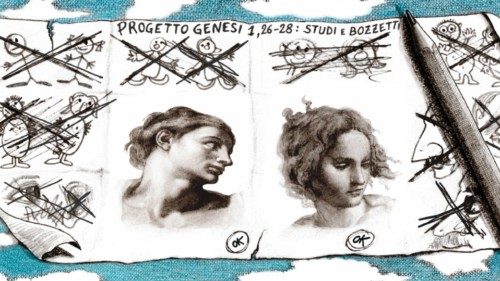
The discourse Pope Francis delivered to a group of artists he received in audience in the Sistine Chapel on Friday morning, 23 June, is another one of those discourses which, like a mine, contains many treasures and precious gems. It is a text that should be read and reread and reflected upon. Today, while it is still “fresh” in our minds, we can begin to reflect on some of the many ideas it puts forth. For example, the pairing of art and novelty. The artist has sharp eyes like those of a child, “who grasps reality”, the Pope said, giving “free rein to originality, novelty and creativity, and thus bring[ing] into the world something new and unprecedented. In doing so, artists unmask the lie that man is a ‘being towards death’. We must certainly come to grips with our mortality, yet we are beings not towards death but towards life”.
Without doing so explicitly, the Pope was referencing the ideas of German philosopher Martin Heidegger, a brilliant, unsettling and central figure of the 1900s, who developed this concept of existence as “being towards death”, in his essays. According to the Pope, the presence of art and artists is a denial of this idea and, confirming this immediately after, he quotes Hannah Arendt, who was first Heidegger’s pupil and then his lover: “A great thinker like Hannah Arendt affirms that the hallmark of humanity is the ability to bring newness into the world”.
And here the Pope introduces the subject of paternity. More than a century ago, English author Chesterton pointed out that: “Artistic paternity is as wholesome as physical paternity” (and therefore that “critics are much madder than poets”). However, the Pope does not want to speak about sanity, but rather of novelty: “This is part of our richness as human beings: to bring newness. Even in nature, procreation brings newness with every child who comes into the world. Openness and newness. That is what you bring, as artists, by cultivating your own originality. In your creations, you always put something of yourself, as unique beings like the rest of us, but for the sake of creating something even greater. With your talents, you bring to light something exceptional; you enrich the world with something new”. “Art is meant to disturb, science reassures”, Georges Braque said. It is a topic that is very dear to the Pope, who in his discourse to the artists, recalled that “neither art nor faith can leave things simply as they are: they change, transform, move and convert them. Art can never serve as an anesthetic; it brings peace, yet far from deadening consciences, it keeps them alert”.
In today’s world, which is so “anaesthetized”, in the sense of nullifying sensibility, and thus at the same time, against pain but also against beauty, artists become “visionaries, men and women of discernment, critical consciences”. This is why the Pope considers them his allies; artists allied with him and with God. All three share a passion, a great shared passion: “I consider you allies in so many things that are dear to me, like the defence of human life, social justice, concern for the poor, care for our common home, universal human fraternity. The humanness of humanity is dear to me, the human dimension of humanity. Because that is also the great passion of God”. And God is the First and the Supreme artist, who lives his creativity with passion, which includes the passion for his only Son who gives life to men and women and who is our salvation. Thus, each in their own way, artists too live their artistic vocation “passionately”, and the “creativity of the artist can thus be said to share in God’s own passion for creation, the passion with which he created. You are sharers in God’s dream”! God’s dream, the mystery that surrounds creation, passes through the passion of the Son, by his kenosis that leads him to live through all human experiences, even death and to give them meaning. In the same way, artists experience the mystery of human existence intensely, first-hand, and they are capable of making us taste its flavours, see colours, light and shadows.
“Often, as artists, you attempt to plumb the depths of the human condition, its dark abysses”, the Pope said. “We are not all light, and you remind us of this. At the same time, there is a need to let the light of hope shine in that darkness, in the midst of our selfishness and indifference. Help us to glimpse the light, the beauty that saves”, he added.
This is the great human and supreme task of artists that the Pope wished to remind to the over 200 representatives of all art fields, gathered before Michelangelo’s Last Judgment.
By Andrea Monda




 Purchase the Encyclical here Fratelli Tutti
Purchase the Encyclical here Fratelli Tutti